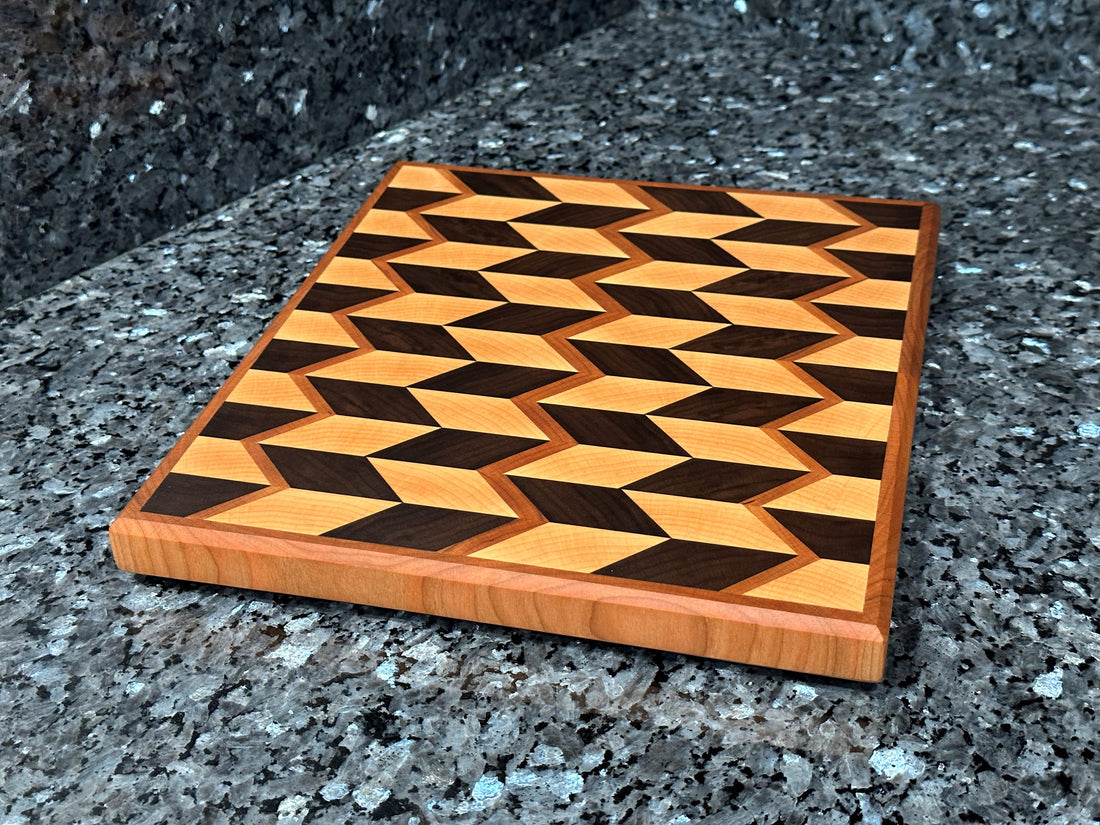
Are Wood Cutting Boards Right For You?
Share
When it comes to kitchen essentials, cutting boards are a must-have, but not all cutting boards are created equal. Among the various options available, wood cutting boards stand out as a favorite for many home cooks and professional chefs alike.
What are the pros and cons of wood cutting boards?
Wood cutting boards have a range of pros and cons. Here’s a quick overview:
Pros
Durability: High-quality wood boards can last for years with proper care.
Knife Friendly: Wood is gentle on knife edges, helping them stay sharp longer.
Aesthetic Appeal: They often have a natural, warm look that enhances kitchen decor.
Antimicrobial Properties: Some studies suggest that wood has natural antibacterial properties, which can help reduce bacteria.
Self-Healing: Wood fibers can close up after knife cuts, reducing grooves where bacteria can thrive.
Cons
Maintenance: Requires regular oiling and proper cleaning to prevent warping and cracking.
Weight: They can be heavier than plastic boards, making them less portable.
Cost: Good quality wood boards can be more expensive than other materials.
Staining and Odors: Wood can absorb flavors and odors from strong-smelling foods.
Not Dishwasher Safe: They need to be hand-washed, which can be less convenient.
Why People Love Wood Cutting Boards?
While subjective, there's quite a few reasons why wood cutting boards get a lot of attention.
Durability and Longevity
Wood cutting boards are known for their durability. With proper care, a high-quality wooden board can last for decades, often becoming a cherished kitchen heirloom.
Self-Healing Properties
One of the unique features of wood is its "self-healing" ability. When you cut on a wooden surface, the fibers of the wood can close up around the cut, reducing the appearance of knife marks over time. This means that, with regular maintenance, your board can look good for years, preserving its aesthetic appeal.
Natural Antibacterial Properties
Certain types of wood, such as bamboo and maple, have natural antibacterial properties.
Aesthetic Appeal
Wooden cutting boards bring a warm, rustic charm to any kitchen. Available in a variety of wood types, colors, and designs, they can complement your kitchen decor beautifully. Whether you're serving cheese at a dinner party or simply using it for daily meal prep, a wooden board can elevate your presentation.
Gentle on Knives
Wood is much kinder to your knives compared to harder surfaces like glass or ceramic. Cutting on a wooden board helps maintain the sharpness of your blades longer, reducing the need for frequent sharpening. This gentle surface can make a noticeable difference for those who value their kitchen tools.
Versatility
Wood cutting boards are incredibly versatile. They can be used for slicing, chopping, and serving, making them a multi-functional tool in the kitchen. From prepping ingredients to serving up a charcuterie board, a wooden cutting board can seamlessly transition from food prep to dining.
Eco-Friendly Choice
For those concerned about the environment, wood cutting boards can be a more sustainable choice. Many manufacturers source wood from responsibly managed forests, and wood is biodegradable, unlike plastic boards. Choosing a wooden cutting board supports a more sustainable kitchen practice.
The Joy of Maintenance
While some might see maintaining a wood cutting board as a chore, many enjoy the ritual of caring for their board. Regular oiling and proper cleaning not only enhance the wood's longevity but also create a deeper connection between the cook and their kitchen tools. It’s a mindful practice that can be quite rewarding.
What Type of Wood Cutting Board Is Best?
While there is no "best" wood for a cutting board, they should all be made from varieties of hardwoods instead of softer ones such as pine or cedar. Choosing the right type of wood for your cutting board can greatly affect its performance and longevity. Here are some of the most popular options:
Maple
Maple is one of the most popular choices for cutting boards. It’s hard, durable, and has a fine grain that resists knife marks. Its natural antibacterial properties make it a safe option for food preparation.
Walnut
Walnut cutting boards are prized for their rich color and beautiful grain patterns. They are slightly softer than maple, which makes them gentle on knives, while still offering good durability.
Cherry
Cherry wood develops a beautiful patina over time, enhancing its aesthetic appeal. It’s moderately hard and offers a warm, reddish hue, making it a stunning addition to any kitchen.
Bamboo
Though technically a grass, bamboo is a popular eco-friendly choice. It’s lightweight and has natural antibacterial properties. However, bamboo boards can be harder on knives compared to hardwood options.
Wood Cutting Board Maintenance
To ensure your wood cutting board remains in top condition, follow these simple maintenance tips:
Regular Cleaning
After each use, wash your wooden cutting board with warm, soapy water. Avoid soaking it or putting it in the dishwasher, as excess moisture can warp the wood. Instead, rinse it off and dry it immediately with a clean cloth.
Oiling
Every few weeks, or whenever the board starts to look dry, apply a food-safe mineral oil or a specialized wood conditioner. Use a clean cloth to rub the oil into the wood, allowing it to soak in. This helps prevent cracking and drying out, keeping the board looking fresh. We recommend our Space Wax Wood Conditioner made from 100% food grade mineral oil and organic bees wax (it smells like honey!).
Avoid Extreme Temperatures
Keep your wooden cutting board away from heat sources and direct sunlight. Extreme temperatures can cause the wood to warp or crack.
Sanding
Over time, if your board develops deep grooves or scratches, you can sand it lightly with fine-grit sandpaper to smooth the surface. Always follow up with oiling to restore its protective finish.
For more information about wood cutting board maintenance, check out our educational "How to Guide" Cutting Boards 101.
How are wood cutting boards made?
The craftsmanship behind handmade wood cutting boards is both an art and a science. Here’s a brief overview of how they are typically made:
Material Selection
High-quality cutting boards are often made from hardwoods such as maple, walnut, or cherry. These woods are chosen for their density, durability, and natural beauty.
Milling
Once the wood is selected, it is cut into planks and milled to the desired thickness. The milling process ensures that each piece is smooth and free of imperfections.
Assembly
Planks are often glued together to create a larger surface. For end grain boards, the blocks are arranged vertically, which enhances the board’s durability and self-healing properties.
Shaping and Finishing
After assembly, the board is shaped and sanded to achieve a smooth finish. This process may include routing edges for a more polished look. Finally, a food-safe finish is applied to protect the wood and enhance its natural beauty.
Wood cutting boards have earned their place in kitchens around the world for good reason. Their durability, natural properties, and aesthetic charm make them a beloved choice for anyone who enjoys cooking. If you’re considering adding one to your kitchen arsenal, remember that with a little care, a wooden cutting board can be a reliable and beautiful tool for years to come.
